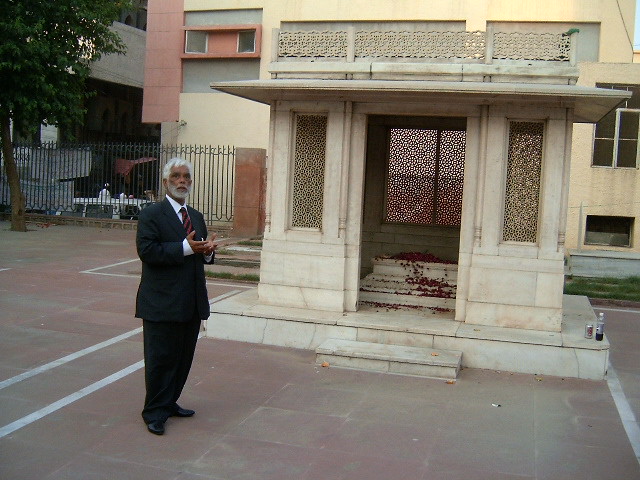By Firoz Bakht Ahmed, IANS,
‘Aah ko chaahiye ik umr asar hone tak/
Kaun jeeta hei tirii zulf ke sar honey tak’
(The sighs of love a life-time need, their object to attain/
Who lives long enough for your dark mysteries to retain)
The iconic Urdu poet died Feb 15, 1869, in his Ballimaran haveli in the walled city of old Delhi’s Shahjahanabad and was buried near Chaunsath Khamba, close to Hazrat Nizamuddin’s shrine. There was nothing to mark his last resting place for a century later till an ardent fan, an Englishman, came to Delhi in search of his grave.
To his disappointment, he couldn’t find it. He then wrote an article in one of the newspapers about it, after which it came to light that Ghalib, after death, didn’t have a place to call his own. That’s when a tomb was built for him and beautified by the efforts of actor Sohrab Modi and Hakim Abdul Hameed of Hamdard.

Ghalib’s tomb
The tomb, like most heritage structures in the city, is under the care of the Archaeological Survey of India but is run in a most haphazard way. The keys to the entrance have been entrusted to the guards. From there begins the ordeal for the visitor.
After asking for the keys from some five people around, an old guard called Tauqeer, shouts, “Babu bhai”. But no one turns up. Finally, he looks for it in the most unlikely places – a mug, a torn black umbrella and broken earthenware. Finally, he finds it – in the base of the mug. Sad though, but true.
‘Koi virani si virani hai/
Dasht ko dekh ke ghar yaad aaya’
(It is desolation personified/
I saw the wilderness and remembered my abode)
Ghalib wrote it only to see it turn into a prophetic couplet on the condition of his habitation and last resting place.
The condition of Ghalib’s blatantly neglected haveli (mansion) is no better, with the 130 sq yard haveli still lying decrepit without any life infused into it by way of a reading room, a stall, the sale of his diwans (collections) and a kiosk for tea. Despite repeated representations to the Delhi government, nothing has been done to beautify it or make it a living monument to one of the most well-known literary figures of the city.
Like death, life wasn’t exactly kind to Ghalib. He lost everyone he loved. In childhood, he lost his father and in adolescence his brother. He became a father of seven sons, but none survived.
Defeated, he adopted a child but even the adopted son expired in youth. These successive tragedies broke his spirit but he consoled himself that if all that happens is God’s will, one cannot fight him.
But as he told his admirer and fellow poet Nawab Mustafa Khan ‘Shefta’ that one can complain and cry against divine dictates to make the heart feel lighter:
‘Gham-e-hasti ka Asad kis se ho juz marg ilaaj/
Shamma har rang mein jalti hai sahar hone tak’
(There is no remedy to the sufferings of life for Asad/
The flame burns in every colour until the dawn).
It is said that he was the heir to a great legacy but Ghalib, valuing human relations more, had little significance for the wealth left by his forefathers. His poetry reflected life through a collage of indefinite human roles. His persona like his poetry had that extra dimension that made those who admired him get hooked on to him forever.
It is said that he would sit all night by a flickering lamp, humming and mulling over his thoughts, all the while playing with a long piece of cloth.
When he felt satisfied with a verse, he tied a firm knot on the cloth as a reminder. He would do that all night. Next morning, when he awoke, he would sit with the cloth and one by one untie the knots, gradually and carefully recalling every verse.
‘Thhi khabar garm ke Ghalib ke urenge purzey/
Dekhney hum bhi gaye pe tamasha na hua!’
(News was in the air about a desecrated and defiled Ghalib/
We also went to witness but found nothing glib).
Maybe his years at Ballimaran were unhappy, maybe the angst gave birth to such marvellous poetry. Maybe, that is why poetry lovers from all over the world still negotiate the by-lanes of Chandni Chowk to visit a small dirty corner of a huge, beautiful city. Even today!
(14-02-2013-Firoz Bakht Ahmed is a commentator on educational, social and religious issues. The views expressed are personal. He can be contacted at [email protected])
